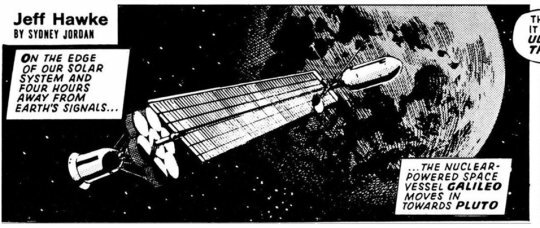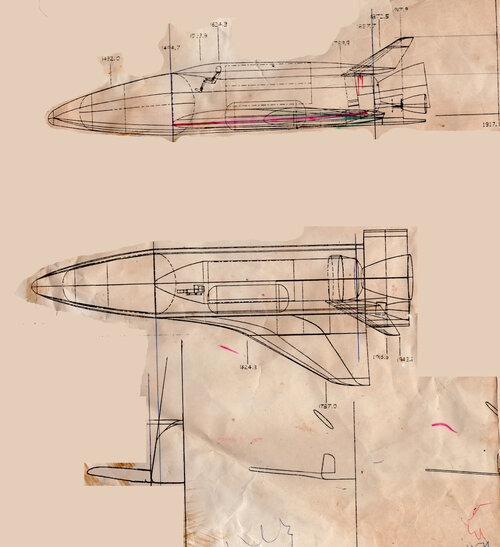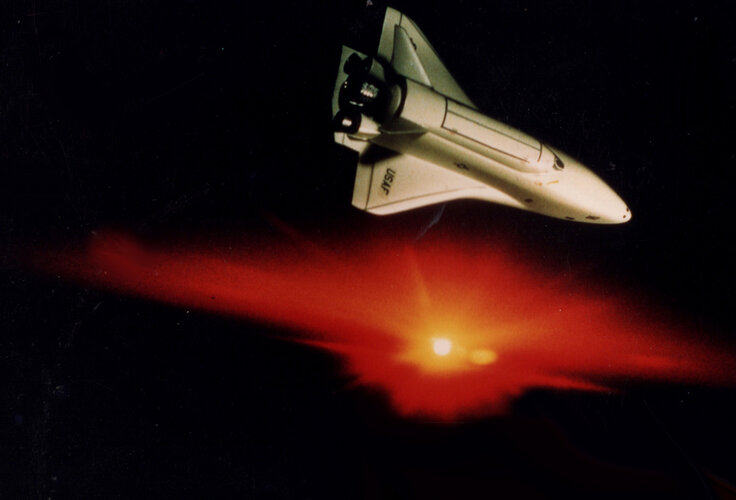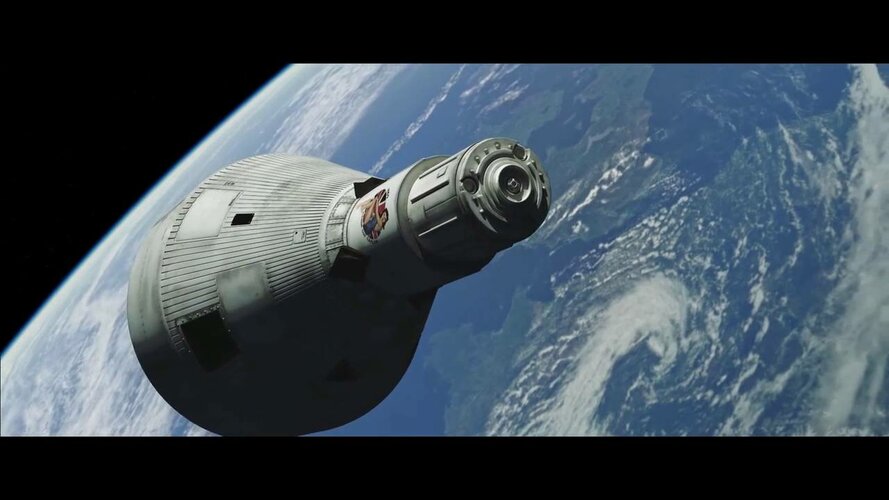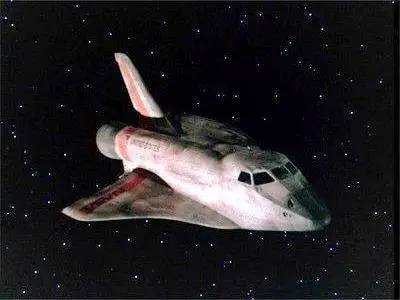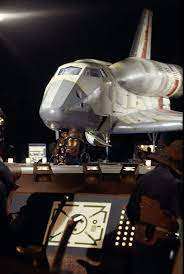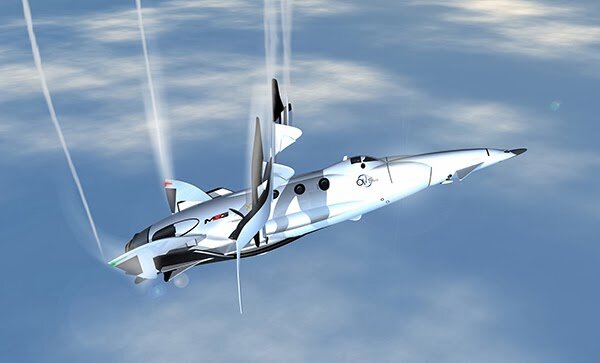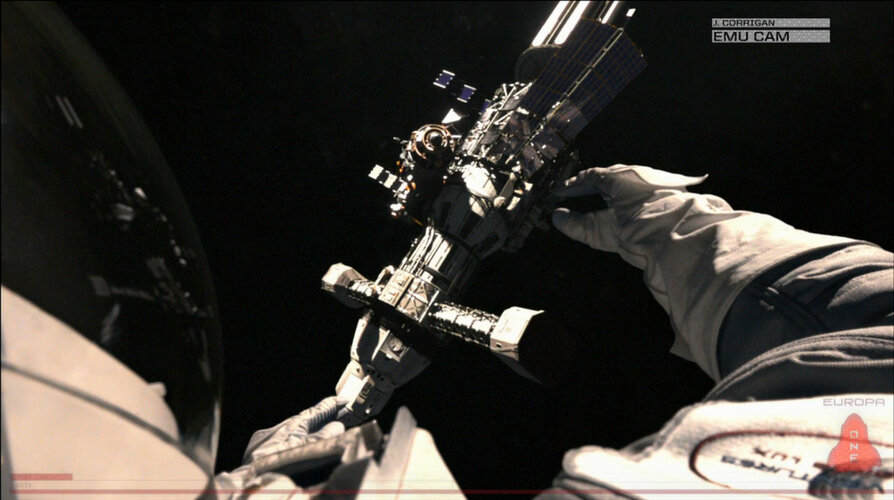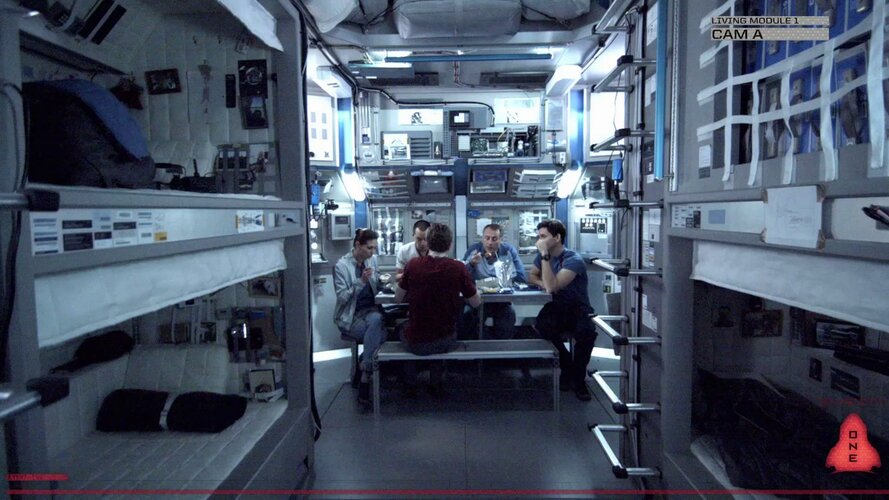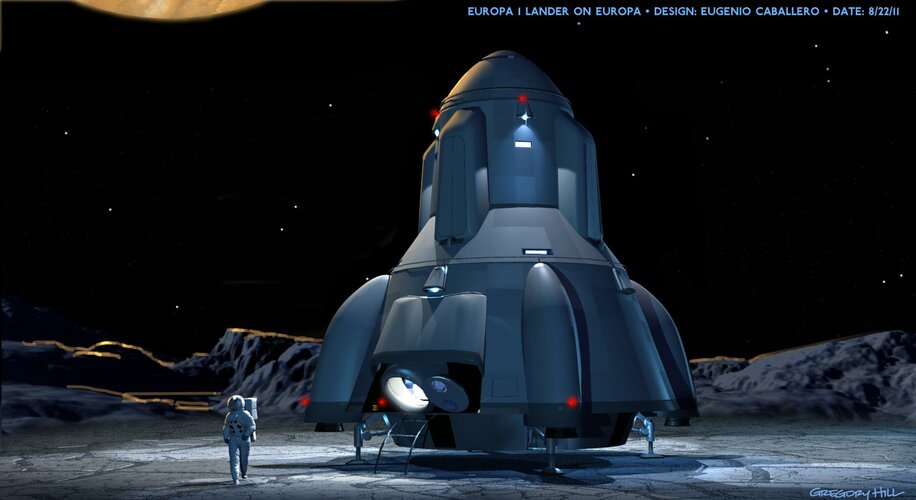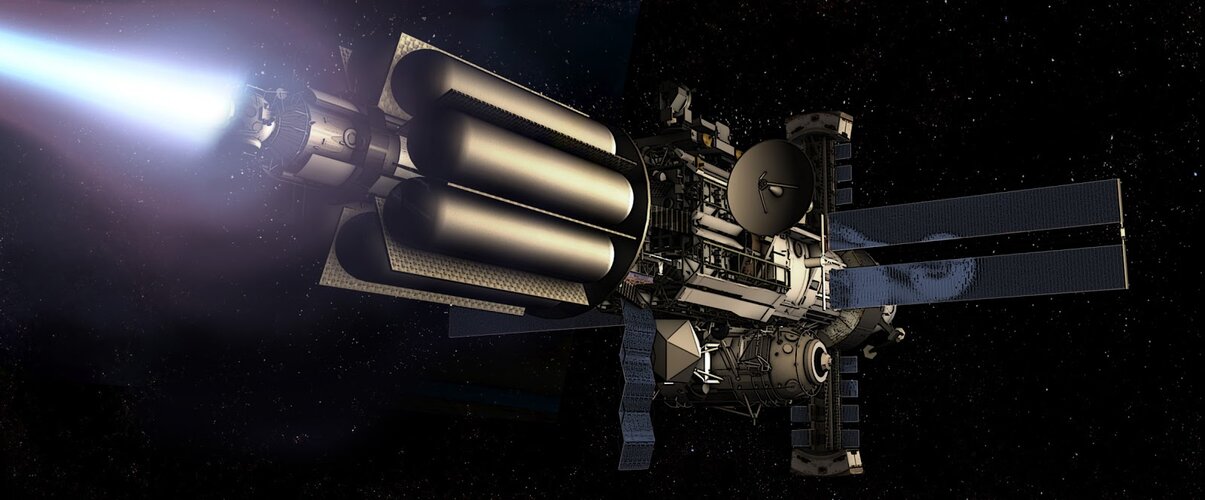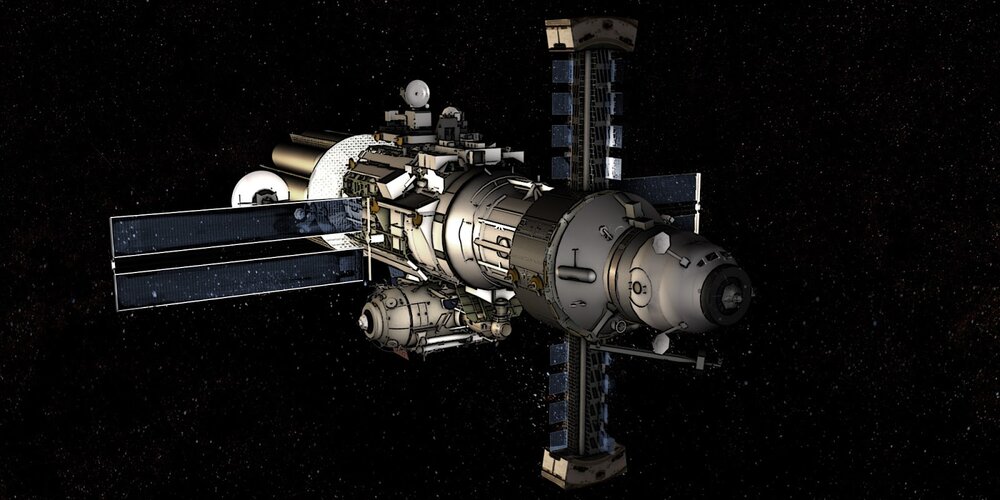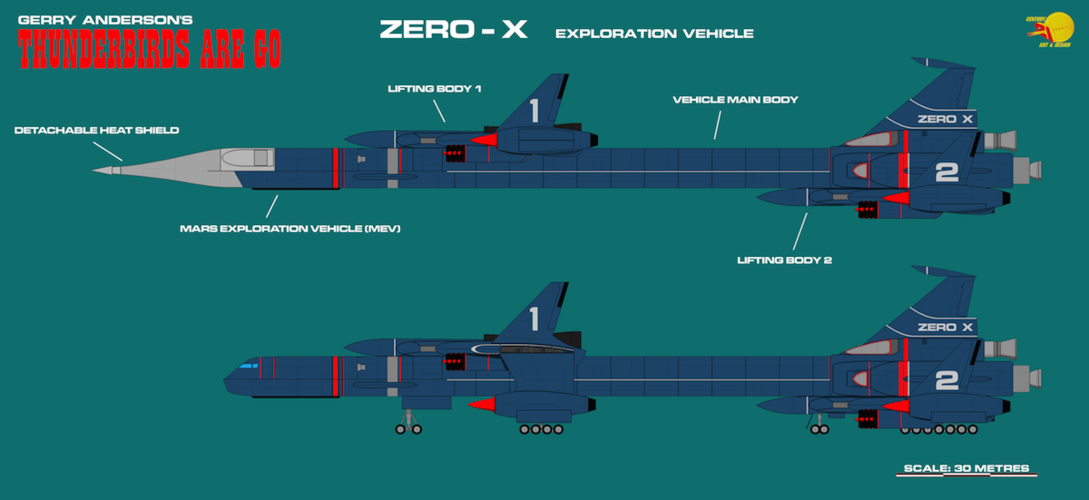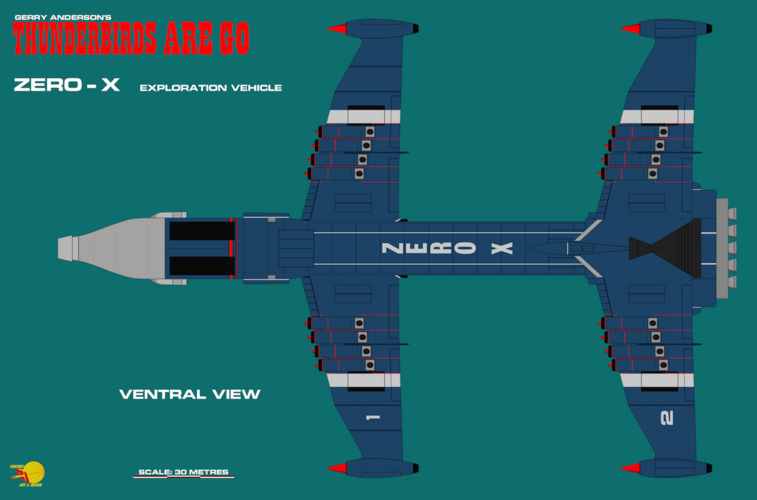You are using an out of date browser. It may not display this or other websites correctly.
You should upgrade or use an alternative browser.
You should upgrade or use an alternative browser.
Fictional (But Realistic) Spacecraft
- Thread starter ozmosis
- Start date
archipeppe
ACCESS: Top Secret
- Joined
- 18 October 2007
- Messages
- 2,431
- Reaction score
- 3,144
I don't know if it was originally meant by Ordway and his team, but for sure what finally become the Orion III had any detachable booster.What Ron Miller depicted, is label in Lang book as "Spaceplane with detachable rocket booster"
It was a TSTO with a winged and manned first stage, even the idea to jettison the nuclear engines section in order to perform a glided reentry (like Shuttle) seems to be rather odd. Mostly because all the Orion design screams out "full reusability".
I stay ony position such jettison could happen only in case of emergency, like is logic to expect.
southwestforests
ACCESS: Top Secret
- Joined
- 28 June 2012
- Messages
- 740
- Reaction score
- 1,178
Independent of the look of the visual remember that you still have to have enough velocity to escape the planet's gravity well.The Discovery suddenly having chemical booster rockets on its escape from Jupiter in the film 2010 always nags me. Looked impressive on screen but completely wrong given it was nuclear powered (and probably never needed such thrust given it was designed for long spaceflights with its crew mostly in hibernation and was built in space).
For Jupiter, 59.5 kilometers per second
For Earth, 11.19 kilometers per second.
Another thing to keep in mind,
The gravity of Jupiter affects every planet to one degree or another. It is strong enough to tear asteroids apart and capture 64 moons at least. Some scientist think that Jupiter destroyed many celestial objects in the ancient past as well as prevented other planets from forming. How’s that for a powerful neighbor?
Here’s an article from Universe Today about how Jupiter’s gravity might actually wreck the Solar System, and here’s an article about how big planets like Jupiter could get.

How Strong Is Jupiter's Gravity?
Jupiter is the most massive planet in our Solar System and; therefore, the gravity of Jupiter is the most intense in the Solar System. The gravity of Jupiter is 2.5 times what it is here on Earth. In the 1990s Jupiter’s gravity tore apart Comet P/Shoemaker-Levy 9 and pulled the broken pieces...
 www.universetoday.com
www.universetoday.com
martinbayer
ACCESS: Top Secret
- Joined
- 6 January 2009
- Messages
- 3,342
- Reaction score
- 3,801
Clarke's description of the Orion III reusable launch system in his 2001 novelization, see https://ia600505.us.archive.org/18/items/SpaceOdyssey_819/2001_A_Space_Odyssey_-_Arthur_C_Clarke.pdf, is remarkably consistent with the vision he first laid out in Prelude to Space.What Clarke described in Prelude to Space was essentially a sled launched TSTO (Two Stage To Orbit), where a manned reusable spaceplane was used to place in orbit a manned lunar spacecraft.The most seminal must surely be the moon rocket described by Arthur C Clarke in his Prelude to Space. It was a step-rocket, but the first stage at least had wings and it was launched off a giant ski-jump built up the side of a mountain. The jump was a railway track, to solve the steering problem.
Clarke envisioned the nuclear propulsion to solve the mass ratio issue.
Conceptually it was derived by the Sanger "Silbervogel" wartime project.
It became the basis for the Pan Am Orion III portrayed in 2001 movie.
View attachment 688180
I could see this as a space platform of some kind

 saturn3makingof.com
saturn3makingof.com

saturn survey space station
Saturn Survey space station in orbit around Saturn (screen cap courtesy dimensionfantastica.blogspot.com)
Paul Lloyd
I really should change my personal text
- Joined
- 21 May 2012
- Messages
- 29
- Reaction score
- 114
jeffb
ACCESS: Top Secret
- Joined
- 7 October 2012
- Messages
- 1,270
- Reaction score
- 1,901
ISV Venture Star from Avatar - extra points for cool because it has the engines in front and pulls the rest of the ship along behind it.
Thrust is in the direction of the green arrow. Pic at bottom is the launch from Earth configuration (minus solar sail).
In the upper diagram is a green arrow at the ship's nose, indicating the direction of flight. The ship is 1.5 kilometers long. In the Sol departure phase, a battery of orbital lasers illuminates a 16 kilometer diameter photon sail attached to the ship's nose (sail not shown). A mirror shield on the ship's rear prevents the laser beams from damaging the ship. The lasers accelerate the ship at 1.5 g for 0.46 year. At the end of this the ship is moving at 70% the speed of light (210,000 kilometers per second).
Keep in mind that battery of orbital lasers is going to have to be absolutely huge if it is going to push a lightsail at 1.5 g. This is not going to be a tiny satellite in LEO.


Went to see the new Avatar 2 movie yesterday and I'm pleased to announce that the ISV Venture Star and the sky people are back - in force!
Won't provide any spoilers but the arrival scene is pretty spectacular as is the method used to land very large payloads on the surface of Pandora. Great stuff!
Scott Kenny
ACCESS: USAP
- Joined
- 15 May 2023
- Messages
- 11,279
- Reaction score
- 13,729
Someone failed to run the energy numbers for the Venture Star. lightsail propulsion is 300 megawatts per newton of thrust.ISV Venture Star from Avatar - extra points for cool because it has the engines in front and pulls the rest of the ship along behind it.
Thrust is in the direction of the green arrow. Pic at bottom is the launch from Earth configuration (minus solar sail).


Launching a ship that big at 1.5gees and those are going to be yottawatts of coherent light...
mr5oa
Retired Aerospace prototype & display Model Maker
- Joined
- 26 February 2018
- Messages
- 29
- Reaction score
- 147
This was a two-man space shuttle proposal, That I was contracted to make back too many years to recall!There are always tons of spacecraft in the world of science fiction but I am always especially looking out for ones that look plausible and could be built today or in the near future. First are some sketches and designs for various vehicles shown in the Japanese animated series "Gundam" (Set in the 22nd century) (Pictures from http://aboutgundamwing.com/mecha_seriesmechanical.htm)
Attachments
martinbayer
ACCESS: Top Secret
- Joined
- 6 January 2009
- Messages
- 3,342
- Reaction score
- 3,801
So, if I understand correctly, the twin propulsion system units (assuming they are of the reactive type) shown on the right of the lower illustration are exhausting towards the left, and smack dab onto whatever the triple canopy layer panels on the left side are supposed to do? Dear god, I wish I could have become a movie designer and have gotten away with idiotic crap like that for a pretty penny... Why would this be realistic???Someone failed to run the energy numbers for the Venture Star. lightsail propulsion is 300 megawatts per newton of thrust.
Launching a ship that big at 1.5gees and those are going to be yottawatts of coherent light...
Last edited:
martinbayer
ACCESS: Top Secret
- Joined
- 6 January 2009
- Messages
- 3,342
- Reaction score
- 3,801
"Like" is by no means the same criterion as "realistic".I like the Enzmann ship design.
- Joined
- 29 July 2009
- Messages
- 1,766
- Reaction score
- 2,451
An interesting retro fictional spacecraft is from the 2016 movie Capsule. Appears to be a little roomy compared to Mercury and maybe a bit closer to Gemini in terms of cabin volume. Panel looks similar to Mercury.
View: https://www.youtube.com/watch?v=yUcEVmhNIK8
Attachments
archipeppe
ACCESS: Top Secret
- Joined
- 18 October 2007
- Messages
- 2,431
- Reaction score
- 3,144
Scott Kenny
ACCESS: USAP
- Joined
- 15 May 2023
- Messages
- 11,279
- Reaction score
- 13,729
The engines exhaust is at a slight angle, to clear the habitat section.So, if I understand correctly, the twin propulsion system units (assuming they are of the reactive type) shown on the right of the lower illustration are exhausting towards the left, and smack dab onto whatever the triple canopy layer panels on the left side are supposed to do? Dear god, I wish I could have become a movie designer and have gotten away with idiotic crap like that for a pretty penny... Why would this be realistic???
The model...or one like it, was modified for BSG as a dissident craft and as Buck's craft on the Searcher.An oldie but goodie classic: the Ranger 3 shuttle-like one man spacecraft from Buck Rogers TV serial of late 70's....
View attachment 703453
View attachment 703454
View attachment 703456
View attachment 703455
It withstood hostile fire from a Hatchet fighter... probably thanks to thermal tiles.
Huh. That's a Rockwell TAV/Space Sortie/military spaceplane from the 80's. Do you have more on this?This was a two-man space shuttle proposal, That I was contracted to make back too many years to recall!
southwestforests
ACCESS: Top Secret
- Joined
- 28 June 2012
- Messages
- 740
- Reaction score
- 1,178
Research the subject, mate, research the subject,and smack dab onto whatever the triple canopy layer panels on the left side are supposed to do? Dear god, I wish I could have become a movie designer and have gotten away with idiotic crap like that for a pretty penny... Why would this be realistic???
When acceleration is completed, the ship is rotated 180 degrees so that the mirror shield faces forward.[4] The shield performs another role, acting as a multilayer interstellar debris shield. Although intense magnetic fields are used to deflect stray gas molecules, the occasional dust grain requires a physical barrier. The shield is in multiple layers, spaced one hundred meters apart. Impact of a debris grain (traveling at a relative speed of 0.7C) with the first layer of the shield causes vaporization into a plasma. The spray of plasma particles strikes the second layer, and the impacts cause spalling from the back of the second layer. These particles are stopped by the third layer. A fourth layer acts as a backup in the unlikely event that something gets past the third layer. Once cruise speed is reached, this shield is detached and moved by small thrusters thousands of miles in front of the ship to improve survivability if a larger particle of debris is encountered.[4]
Interstellar Vehicle Venture Star
The Interstellar Vehicle Venture Star (also known as ISV Venture Star, or simply ISV) is one of ten[1] interstellar starships that are part of a looping supply chain for the transport of supplies, equipment, personnel, refined ore, and data between planet Earth and the distant moon Pandora...
- Joined
- 27 September 2006
- Messages
- 6,386
- Reaction score
- 6,760
Gerry Anderson's model vehicles were usually designed to look good on screen and make fun toys for kids.
Perhaps the best example of this was the Zero X Mars Exploration ship .
View: https://youtu.be/x8PR3QIwXHs
Perhaps the best example of this was the Zero X Mars Exploration ship .
martinbayer
ACCESS: Top Secret
- Joined
- 6 January 2009
- Messages
- 3,342
- Reaction score
- 3,801
Technobabble is cheap, as opposed to *actual* research.Research the subject, mate, research the subject,

Interstellar Vehicle Venture Star
The Interstellar Vehicle Venture Star (also known as ISV Venture Star, or simply ISV) is one of ten[1] interstellar starships that are part of a looping supply chain for the transport of supplies, equipment, personnel, refined ore, and data between planet Earth and the distant moon Pandora...james-camerons-avatar.fandom.com
Last edited:
Scott Kenny
ACCESS: USAP
- Joined
- 15 May 2023
- Messages
- 11,279
- Reaction score
- 13,729
You know that ship was designed by an actual rocket scientist, right? Dr. Charles Pellegrino. https://charlespellegrino.com/nuclear-propulsion/Technobabble is cheap, as opposed to *actual* research.
martinbayer
ACCESS: Top Secret
- Joined
- 6 January 2009
- Messages
- 3,342
- Reaction score
- 3,801
There is a *very* fundamental reason why socalled "rocket scientists" are distinct and separate from aerospace engineers - the former come up with basic theories and principles, while the latter have to deal with the concrete implementation and translation of those concepts into actual functional hardware at TRL 9. The next time you have some strange health symptom or condition that concerns you, are you going to turn to a biologist, or to a medical professional? In addition, Pellegrino's Wikipedia entry, see https://en.wikipedia.org/wiki/Charles_R._Pellegrino, does not exactly instill confidence, since his PhD claim seems to be completely bogus, and any "scientist" who, according to his own website, apparently vacillates between archaeology, paleontology, space science, the Titanic, and some Hiroshima controversy seems to have a problem focusing...You know that ship was designed by an actual rocket scientist, right? Dr. Charles Pellegrino. https://charlespellegrino.com/nuclear-propulsion/
Last edited:
Scott Kenny
ACCESS: USAP
- Joined
- 15 May 2023
- Messages
- 11,279
- Reaction score
- 13,729
Or, you know, those are his _hobbies_?There is a *very* fundamental reason why socalled "rocket scientists" are distinct and separate from aerospace engineers - the former come up with basic theories and principles, while the latter have to deal with the concrete implementation and translation of those concepts into actual functional hardware at TRL 9. The next time you have some strange health symptom or condition that concerns you, are you going to turn to a biologist, or to a medical professional? In addition, Pellegrino's Wikipedia entry, see https://en.wikipedia.org/wiki/Charles_R._Pellegrino, does not exactly instill confidence, since his PhD claim seems to be completely bogus, and any "scientist" who, according to his own website, apparently vacillates between archaeology, paleontology, space science, the Titanic, and some Hiroshima controversy seems to have a problem focusing...
martinbayer
ACCESS: Top Secret
- Joined
- 6 January 2009
- Messages
- 3,342
- Reaction score
- 3,801
I'd say having a lot of "diverse" hobbies is probably an absolutely swell thing for him, but it might distract him a bit from focusing on obtaining an actual aerospace PhD, which I believe you meant to refer to as his qualification for dabbling in conceptual movie storyboard pseudoscience...
Last edited:
Scott Kenny
ACCESS: USAP
- Joined
- 15 May 2023
- Messages
- 11,279
- Reaction score
- 13,729
I doubt you give a shit, but Atomic Rockets, that website of all the hard physics equations to make your brain hurt, seems to think that ISV Venture Star would do the job as described.I'd say having a lot of "diverse" hobbies is probably an absolutely swell thing for him, but it might distract him a bit from focusing on obtaining an actual aerospace PhD, which I believe you meant to refer to as his qualification for dabbling in conceptual movie storyboard pseudoscience...
martinbayer
ACCESS: Top Secret
- Joined
- 6 January 2009
- Messages
- 3,342
- Reaction score
- 3,801
At this point I'd like to introduce the NASA Technology Readiness Level (TRL) concept, see https://www.nasa.gov/pdf/458490main_TRL_Definitions.pdf, into the discussion, although I really do believe it to be an incomplete/imperfect scale in its original version, since in my honest opinion there should be an additional TRL 0 of "basic principles postulated". You first read it here, folks!I like the Enzmann ship design.
martinbayer
ACCESS: Top Secret
- Joined
- 6 January 2009
- Messages
- 3,342
- Reaction score
- 3,801
Is there a specific reason why you did not have the courtesy to provide an actual specific link to back up your claim? But then again, any website that uses the term "atomic" instead of "nuclear" might be a tad outdated... Also, any fanboi website is not really a substitute for actually vetted objective scientific evidence, and a dedication to the dead pulp scify writer Robert Heinlein does not really instill a whole lot of scientific confidence in me either... To quote the late great Carl Sagan's standard, ECREE, so hic Rhodus, hic salta! In other words, being able to provide at the very least one single academically accepted paper to support your specific assertions would reeeally help the case you are trying to make...I doubt you give a shit, but Atomic Rockets, that website of all the hard physics equations to make your brain hurt, seems to think that ISV Venture Star would do the job as described.
Last edited:
- Joined
- 6 November 2010
- Messages
- 5,238
- Reaction score
- 5,454
Try this:specific link
Search on page for 'Venture Star'
Scott Kenny
ACCESS: USAP
- Joined
- 15 May 2023
- Messages
- 11,279
- Reaction score
- 13,729
Because I thought typing "atomic rockets Venture Star" into google then pressing enter was within your capabilities.Is there a specific reason why you did not have the courtesy to provide an actual specific link to back up your claim? But then again, any website that uses the term "atomic" instead of "nuclear" might be a tad outdated... Also, any fanboi website is not really a substitute for actually vetted objective scientific evidence, and a dedication to the dead pulp scify writer Robert Heinlein does not really instill a whole lot of scientific confidence in me either... To quote the late great Carl Sagan's standard, ECREE, so hic Rhodus, hic salta! In other words, being able to provide at the very least one single academically accepted paper to support your specific assertions would reeeally help the case you are trying to make...
But since it evidently isn't, here: actual specific link directly to the spot Arjen suggested.
As to peer reviewed, you might want to look at just how much data Atomic Rockets actually has, and just how many people contribute and review any math that shows up.
martinbayer
ACCESS: Top Secret
- Joined
- 6 January 2009
- Messages
- 3,342
- Reaction score
- 3,801
Random quote from your link: "I cannot calculate the exact power rating since figures on the mass of the ISV Venture Star are conspicuous by their absence." As you may know, in real(istic) spaceflight, mass properties are a *critical* parameter in actual vehicle design and engineering. Also, a link from the page you refer to leads to https://james-camerons-avatar.fandom.com/wiki/Interstellar_Vehicle_Venture_Star, which contains this little pearl of wisdom: "Interstellar starships such as the ISV Venture Star require unobtanium in their manufacture, due to unobtanium's role in providing containment for matter-antimatter reactions." UN.OB.TAIN.IUM. Let that sink in for a moment. Your disbelief may be sufficiently suspended to go along with that, but I'm far more comfortable being tethered to *actual* reality when discussing *realistic* spacecraft concepts. For a moment there it occurred to me that perhaps it's time to extend the TRL concept into single negative digit territory, but on second thought, resorting to imaginary numbers would probably be far more appropriate for this particular handwaving fairytale application...Because I thought typing "atomic rockets Venture Star" into google then pressing enter was within your capabilities.
But since it evidently isn't, here: actual specific link directly to the spot Arjen suggested.
As to peer reviewed, you might want to look at just how much data Atomic Rockets actually has, and just how many people contribute and review any math that shows up.
Last edited:
Scott Kenny
ACCESS: USAP
- Joined
- 15 May 2023
- Messages
- 11,279
- Reaction score
- 13,729
Unobtainium was the material that was being mined at Pandora in the movie. If you've seen Avatar (you should, just turn your brain off and enjoy the gorgeous visuals), it's the rocks floating in air. It was critical to solving the Earth's energy problems. Which is hilarious, given the fact that they had made enough antimatter to fuel the Venture Star and had solar arrays big enough to power the lasers to launch it initially.Random quote from your link: "I cannot calculate the exact power rating since figures on the mass of the ISV Venture Star are conspicuous by their absence." As you may know, in real(istic) spaceflight, mass properties are a *critical* parameter in actual vehicle design and engineering. Also, a link from the page you refer to leads to https://james-camerons-avatar.fandom.com/wiki/Interstellar_Vehicle_Venture_Star, which contains this little pearl of wisdom: "Interstellar starships such as the ISV Venture Star require unobtanium in their manufacture, due to unobtanium's role in providing containment for matter-antimatter reactions." UN.OB.TAIN.IUM. Let that sink in for a moment. Your disbelief may be sufficiently suspended to go along with that, but I'm far more comfortable being tethered to *actual* reality when discussing *realistic* spacecraft concepts. For a moment there it occurred to me that perhaps it's time to extend the TRL concept into single negative digit territory, but on second thought, resorting to imaginary numbers would probably be far more appropriate for this particular handwaving fairytale application...
In addition, the general use of unobtainium is "something which is not currently available, but would have the following properties: ..." Orbital Elevator length carbon nanotubes are unobtainium, for example, but we know exactly what their properties would be if we could make a single molecule 36000km long.
Also, bluntly, the design of the Valkyrie engine is a solved issue, and does not require anything exotic other than antimatter. It relies on some very odd but well established QM and relativistic interactions that are used in particle accelerator experiments since the 1970s involving antimatter. Oh, wait, ALL QM and relativistic interactions are very odd!
Rhinocrates
ACCESS: Top Secret
- Joined
- 26 September 2006
- Messages
- 3,006
- Reaction score
- 7,604
Europa Report. One of those films I like because it shows scientists being scientists.

 www.popsci.com
www.popsci.com

Most of the exterior shots are as if taken from cameras fixed to the spacecraft, so I've shown concept art below.
The centrifuge is a bit underscaled but it's not unlike NASA's real study for Human Outer Planets Exploration (HOPE).

How Realistic Is The Sci-Fi Space Thriller 'Europa Report'?
We chat with Kevin Hand, an astrobiologist who consulted on the film, about realism in space thrillers, why actors are better than robots, and more.

Europa Report - Starring Christian Camargo, Embeth Davidtz, Anamaria Marinca, Michael Nyqvist, Daniel Wu, Karolina Wydra and Sharlto Copley - Now Available on DVD and Blu-ray™
When unmanned probes suggest that a hidden ocean could exist underneath Europa’s icy surface and may contain single-celled life, Europa Ventures, a privately funded space exploration company, sends six of the best astronauts from around the world to confirm the data and explore the revolutionary...
www.magnetreleasing.com
Most of the exterior shots are as if taken from cameras fixed to the spacecraft, so I've shown concept art below.
The centrifuge is a bit underscaled but it's not unlike NASA's real study for Human Outer Planets Exploration (HOPE).
Attachments
martinbayer
ACCESS: Top Secret
- Joined
- 6 January 2009
- Messages
- 3,342
- Reaction score
- 3,801
Well, my dear Scott (weirdly enough though, you're the second Scott I tend to get into arguments with on this august forum - is that karma, synchronicity, or just the result of someone messing with us living in a simulationUnobtainium was the material that was being mined at Pandora in the movie. If you've seen Avatar (you should, just turn your brain off and enjoy the gorgeous visuals), it's the rocks floating in air. It was critical to solving the Earth's energy problems. Which is hilarious, given the fact that they had made enough antimatter to fuel the Venture Star and had solar arrays big enough to power the lasers to launch it initially.
In addition, the general use of unobtainium is "something which is not currently available, but would have the following properties: ..." Orbital Elevator length carbon nanotubes are unobtainium, for example, but we know exactly what their properties would be if we could make a single molecule 36000km long.
Also, bluntly, the design of the Valkyrie engine is a solved issue, and does not require anything exotic other than antimatter. It relies on some very odd but well established QM and relativistic interactions that are used in particle accelerator experiments since the 1970s involving antimatter. Oh, wait, ALL QM and relativistic interactions are very odd!
Last edited:
Scott Kenny
ACCESS: USAP
- Joined
- 15 May 2023
- Messages
- 11,279
- Reaction score
- 13,729
That's what the forward projecting towers are. Plus it uses droplet radiators in cruise that also act as the forward particle shield. In cruise it's still very slowly accelerating, just enough to keep the tether tight as the droplet radiator acts as a reverse thruster.I think the other Scott said it would need massive radiators.
As for "turning your brain off" that was specifically to look at the gorgeous scenery, not to over analyze it to death. Because the plot is somewhere between Pocohontas and Dances with Wolves, and is about as subtle as an anvil dropping from low orbit. There's a reason that Avatar won every technical Oscar in 2009, and not a single one of the story or acting Oscars, not just that it was up against Hurt Locker. Sit down, have some adult beverages, kick back with friends and provide your own rifftrax/MST3K to mock the stupid parts. Because holy shit are there some stupid parts in that movie!Well, my dear Scott (weirdly enough though, you're the second Scott I tend to get into arguments with on this august forum - is that karma, synchronicity, or just the result of someone messing with us living in a simulation- psych?!), as an actual aerospace engineer (check me out at https://www.linkedin.com/in/martinjbayer/) I am just at a complete loss how you could *possibly* square to "just turn your brain off" and "floating rocks" and "currently unavailable unobtainium" (because it's NONEXISTENT, Do'h!!!) with a discussion of fictional but REALISTIC spacecraft??? What on Earth and the rest of the universe makes you possibly think the Venture Star fits into that category??? Have you ever even looked at the TRL definition file I provided??? To quote some random internet guy, research the subject, mate, research the subject...
The rough design of the ship was laid out some 35 years ago, with tech that was at least demonstrated in the lab for dealing with antimatter. The tether material isn't specified, but is likely to be carbon nanotubes for length and strength. Most of the structure within neutron range of the antimatter reaction chamber isn't presently specified but is known to need to be designed around the assumption that it will get a lot of neutron bombardment and also very hot due to all the neutron capture. So it will have to be a self-annealing material, and one that is designed to at least not get weaker as the elements in it transmute. Ideally it would actually get stronger as the elements transmute, but I don't know anywhere near enough nuclear physics to know if that's possible. (That will be one hell of a fun physics project to develop the materials.) You know, kinda like modern nuclear reactors are designed around neutron exposure/embrittlement.
Again, where they knew what materials would work in the design in the 1970s and 80s they specified them, like beryllium windows to the reaction chamber, that antimatter at relativistic speeds could pass through without interaction(!). Because that was all things that they worked with at the various national physics labs.
Where they did not have a material currently available to them, they specified what properties were required for the task. (You know, the current working definition of unobtainium.) As materials were invented/discovered that had those properties, they specified the materials to use, like carbon nanotubes, and supercooled flaked antimatter.
They did the math for a 2-person crew version of their craft.
ISV Venture Star is a much enlarged version of their original design.
The K2
ACCESS: Secret
- Joined
- 29 June 2020
- Messages
- 298
- Reaction score
- 678
The Zero-X. Designed by the late Derek Meddings. It was designed as an interplanetary spacecraft that could take off and land horizontally on Earth.Gerry Anderson's model vehicles were usually designed to look good on screen and make fun toys for kids.
Perhaps the best example of this was the Zero X Mars Exploration ship .
View: https://youtu.be/x8PR3QIwXHs
As with the previous drawings I posted on this forum, the original artist ArthurTwoSheds created these of the Zero-X, and with her permission, I updated them based on material I have of the actual filming miniature.
Attachments
Last edited:
martinbayer
ACCESS: Top Secret
- Joined
- 6 January 2009
- Messages
- 3,342
- Reaction score
- 3,801
NO design that relies on nonexistent materials is anywhere near "realistic" - simple as that. This is about aerospace engineering, not theoretical physics. TRL = 0. Following your logic, the sphere form Wells' "First Men in the Moon" is a realistic design, since all it needs is for Cavorite to be invented! And I don't watch movies with apparently mind numbing plots just to see gravity defying CGI scenery with overgrown Smurfs float by.
Last edited:
Similar threads
-
-
-
Space: 1959 "Space Age" concept poster on cardboard
- Started by Triton
- Replies: 22
-
-
2001: A Space-Time Odyssey
- Started by Michel Van
- Replies: 144


